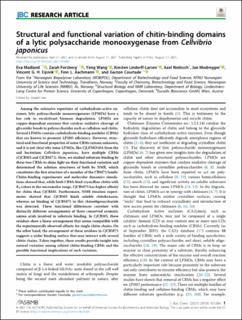| dc.contributor.author | Madland, Eva | |
| dc.contributor.author | Forsberg, Zarah | |
| dc.contributor.author | Wang, Yong | |
| dc.contributor.author | Lindorff-Larsen, Kresten | |
| dc.contributor.author | Niebisch, Axel | |
| dc.contributor.author | Modregger, Jan | |
| dc.contributor.author | Eijsink, Vincent | |
| dc.contributor.author | Aachmann, Finn Lillelund | |
| dc.contributor.author | Courtade, Gaston | |
| dc.date.accessioned | 2021-09-21T06:00:43Z | |
| dc.date.available | 2021-09-21T06:00:43Z | |
| dc.date.created | 2021-08-30T09:27:23Z | |
| dc.date.issued | 2021 | |
| dc.identifier.issn | 0021-9258 | |
| dc.identifier.uri | https://hdl.handle.net/11250/2779693 | |
| dc.description.abstract | Among the extensive repertoire of carbohydrate-active enzymes, lytic polysaccharide monooxygenases (LPMOs) have a key role in recalcitrant biomass degradation. LPMOs are copper-dependent enzymes that catalyze oxidative cleavage of glycosidic bonds in polysaccharides such as cellulose and chitin. Several LPMOs contain carbohydrate-binding modules (CBMs) that are known to promote LPMO efficiency. However, structural and functional properties of some CBMs remain unknown, and it is not clear why some LPMOs, like CjLPMO10A from the soil bacterium Cellvibrio japonicus, have multiple CBMs (CjCBM5 and CjCBM73). Here, we studied substrate binding by these two CBMs to shine light on their functional variation and determined the solution structures of both by NMR, which constitutes the first structure of a member of the CBM73 family. Chitin-binding experiments and molecular dynamics simulations showed that, while both CBMs bind crystalline chitin with Kd values in the micromolar range, CjCBM73 has higher affinity for chitin than CjCBM5. Furthermore, NMR titration experiments showed that CjCBM5 binds soluble chitohexaose, whereas no binding of CjCBM73 to this chitooligosaccharide was detected. These functional differences correlate with distinctly different arrangements of three conserved aromatic amino acids involved in substrate binding. In CjCBM5, these residues show a linear arrangement that seems compatible with the experimentally observed affinity for single chitin chains. On the other hand, the arrangement of these residues in CjCBM73 suggests a wider binding surface that may interact with several chitin chains. Taken together, these results provide insight into natural variation among related chitin-binding CBMs and the possible functional implications of such variation. | en_US |
| dc.language.iso | eng | en_US |
| dc.publisher | Elsevier | en_US |
| dc.rights | Navngivelse 4.0 Internasjonal | * |
| dc.rights.uri | http://creativecommons.org/licenses/by/4.0/deed.no | * |
| dc.title | Structural and functional variation of chitin-binding domains of a lytic polysaccharide monooxygenase from Cellvibrio japonicus | en_US |
| dc.type | Peer reviewed | en_US |
| dc.type | Journal article | en_US |
| dc.description.version | publishedVersion | en_US |
| dc.source.journal | Journal of Biological Chemistry | en_US |
| dc.identifier.doi | 10.1016/j.jbc.2021.101084 | |
| dc.identifier.cristin | 1929609 | |
| dc.relation.project | Novo Nordisk Fonden: NNF18OC0055736 | en_US |
| dc.relation.project | Novo Nordisk Fonden: NNF18OC0032242 | en_US |
| dc.relation.project | Norges forskningsråd: 247001 | en_US |
| dc.relation.project | Norges forskningsråd: 269408 | en_US |
| dc.relation.project | Norges forskningsråd: 262853 | en_US |
| dc.relation.project | Norges forskningsråd: 226244 | en_US |
| cristin.ispublished | true | |
| cristin.fulltext | postprint | |
| cristin.qualitycode | 2 | |

